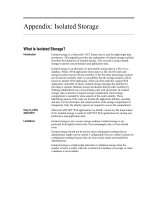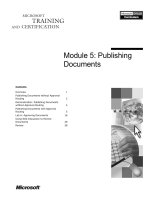Tài liệu Lesson 5: Methods docx
Bạn đang xem bản rút gọn của tài liệu. Xem và tải ngay bản đầy đủ của tài liệu tại đây (51.75 KB, 7 trang )
Using Excellent Tools to Write Web Applications Targeting
the .NET Common Language Runtime (CLR)
[Home] [Up] [Lesson01] [Lesson02] [Lesson03] [Lesson04] [Lesson05]
[Lesson06] [Lesson07] [Lesson08] [Lesson09] [Lesson10] [Lesson11
[Lesson12] [Lesson13]
On sale Now! C#
Unleashed is an in-
depth guide for
intermediate to
advanced software
developers to learn
the C#
programming
language and
serve as a desktop
reference.
.
.
.
.
.
.
.
.
.
.
The C# Station Tutorial
by Joe Mayo, 9/25/00
Lesson 5: Methods
This lesson introduces you to C# Methods. Our objectives are as follows:
l
Understand the structure of a method.
l
Know the difference between static and instance methods.
l
Learn to instantiate objects.
l
Learn how to call methods of an instantiated object.
l
Understand the 4 types of parameters.
l
Learn how to use the "this" reference.
Previously, all of our functionality for each program resided in the Main()
method. While this was adequate for the simple programs we used to
learn earlier concepts, there is a better way to organize your program,
using methods. Methods are extremely useful because they allow you to
separate your logic into different units.
The structure of a method is as follows:
attributes modifiers return-type method-name ( parameters )
{ statements }
We defer discussion of attributes and modifiers to a later lesson. The
return-type can be any C# type. It can be assigned to a variable for use
later in the program. The method name is a unique identifier for what you
wish to call a method. To promote understanding of your code, a method
name should be meaningful and associated with the task the method
performs. Parameters allow you to pass information to and from a
method. They are surrounded by parenthesis. Statements within the
curly braces carry out the functionality of the method.
Listing 5-1. One Simple Method: OneMethod.cs
Page 1 of 7Tutorial
6/24/2002 />using System;
class OneMethod
{
public static void Main()
{
string myChoice;
OneMethod om = new OneMethod();
do
{
myChoice = om.getChoice();
// Make a decision based on the user's choice
switch(myChoice)
{
case "A":
case "a":
Console.WriteLine("You wish to add an address.");
break;
case "D":
case "d":
Console.WriteLine("You wish to delete an address.");
break;
case "M":
case "m":
Console.WriteLine("You wish to modify an address.");
break;
case "V":
case "v":
Console.WriteLine("You wish to view the address list.");
break;
case "Q":
case "q":
Console.WriteLine("Bye.");
break;
default:
Console.WriteLine("{0} is not a valid choice", myChoice);
break;
}
// Pause to allow the user to see the results
Console.WriteLine();
Console.Write("Press any key to continue...");
Console.ReadLine();
Console.WriteLine();
} while (myChoice != "Q" && myChoice != "q"); // Keep going until the
user wants to quit
}
string getChoice()
{
string myChoice;
// Print A Menu
Page 2 of 7Tutorial
6/24/2002 /> Console.WriteLine("My Address Book\n");
Console.WriteLine("A - Add New Address");
Console.WriteLine("D - Delete Address");
Console.WriteLine("M - Modify Address");
Console.WriteLine("V - View Addresses");
Console.WriteLine("Q - Quit\n");
Console.Write("Choice (A,D,M,V,or Q): ");
// Retrieve the user's choice
myChoice = Console.ReadLine();
Console.WriteLine();
return myChoice;
}
}
The program in Listing 5-1 is similar to the DoLoop program from Lesson 4,
except for one difference. Instead of printing the menu and accepting
input in the Main() method, this functionality has been moved to a new
method called getChoice(). The return type is a string. This string is used
in the switch statement in main. The method name "getChoice" describes
what happens when it is invoked. Since the parenthesis are empty, no
information will be transferred to or from the getChoice() method.
Within the method block we first declare the variable "myChoice".
Although this is the same name and type as the "myChoice" variable in
Main(), they are both unique variables. They are local variables and they
are visible only in the block they are declared. In other words, the
"myChoice" in getChoice() knows nothing about the existence of the
"myChoice" in Main(), and visa-versa.
The getChoice() method prints a menu to the console and gets the user's
input. The "return" statement sends the data from the "myChoice"
variable back to the caller, Main(), of getChoice(). Notice that the type
returned by the "return" statement must be the same as the return-type in
the function declaration. In this case it is a string.
In the Main() method we must instantiate a new "OneMethod" object
before we can use getChoice(). This is because of the way getChoice() is
declared. Since we did not specify a "static" modifier (as for Main()),
getChoice() becomes an instance method. The difference between
instance methods and static methods is that multiple instances of a class
can be created (or instantiated) and each instance has it's own separate
getChoice() method. However, when a method is static, there are no
instances of that method, and you can invoke only that one definition of
the static method.
So, as stated, getChoice() is not static and therefore, we must instantiate
a new object to use it. This is done with the declaration "OneMethod om =
Page 3 of 7Tutorial
6/24/2002 />new OneMethod()". On the left hand side of the declaration is the object
reference "om" which is of type OneMethod. The distinction of "om" being
a reference is important. It is not an object itself, but it is a variable that
can refer (or point ) to an object of type OneMethod. On the right hand
side of the declaration is an assignment of a new OneMethod object to the
reference "om". The keyword "new" is a C# operator that creates a new
instance of an object on the heap. What is happening here is that a new
OneMethod instance is being created on the heap and then being assigned
to the om reference. Now that we have an instance of the OneMethod
object referenced by om, we can manipulate that instance through the om
reference.
Methods, fields, and other class members can be accessed, identified, or
manipulated through the "." (dot) operator. Since we want to call
getChoice(), we do so by using the dot operator through the om
reference: "om.getChoice()". The program then executes the statements
in the getChoice() block and returns. To capture the value getChoice()
returns, we use the "=" (assignment) operator. The returned string is
placed into Main()'s local myChoice variable. From there, the rest of the
program executes as you expect, using concepts from earlier lessons.
Listing 5-2. Method Parameters: MethodParams.cs
using System;
class Address
{
public string name;
public string address;
}
class MethodParams
{
public static void Main()
{
string myChoice;
MethodParams mp = new MethodParams();
do
{
// show menu and get input from user
myChoice = mp.getChoice();
// Make a decision based on the user's choice
mp.makeDecision(myChoice);
// Pause to allow the user to see the results
Console.Write("Press any key to continue...");
Console.ReadLine();
Console.WriteLine();
} while (myChoice != "Q" && myChoice != "q"); // Keep going until the user wants to
quit
Page 4 of 7Tutorial
6/24/2002 /> }
// show menu and get user's choice
string getChoice()
{
string myChoice;
// Print A Menu
Console.WriteLine("My Address Book\n");
Console.WriteLine("A - Add New Address");
Console.WriteLine("D - Delete Address");
Console.WriteLine("M - Modify Address");
Console.WriteLine("V - View Addresses");
Console.WriteLine("Q - Quit\n");
Console.WriteLine("Choice (A,D,M,V,or Q): ");
// Retrieve the user's choice
myChoice = Console.ReadLine();
return myChoice;
}
// make decision
void makeDecision(string myChoice)
{
Address addr = new Address();
switch(myChoice)
{
case "A":
case "a":
addr.name = "Joe";
addr.address = "C# Station";
this.addAddress(ref addr);
break;
case "D":
case "d":
addr.name = "Robert";
this.deleteAddress(addr.name);
break;
case "M":
case "m":
addr.name = "Matt";
this.modifyAddress(out addr);
Console.WriteLine("Name is now {0}.", addr.name);
break;
case "V":
case "v":
this.viewAddresses("Cheryl", "Joe", "Matt", "Robert");
break;
case "Q":
case "q":
Console.WriteLine("Bye.");
break;
default:
Console.WriteLine("{0} is not a valid choice", myChoice);
Page 5 of 7Tutorial
6/24/2002 />









